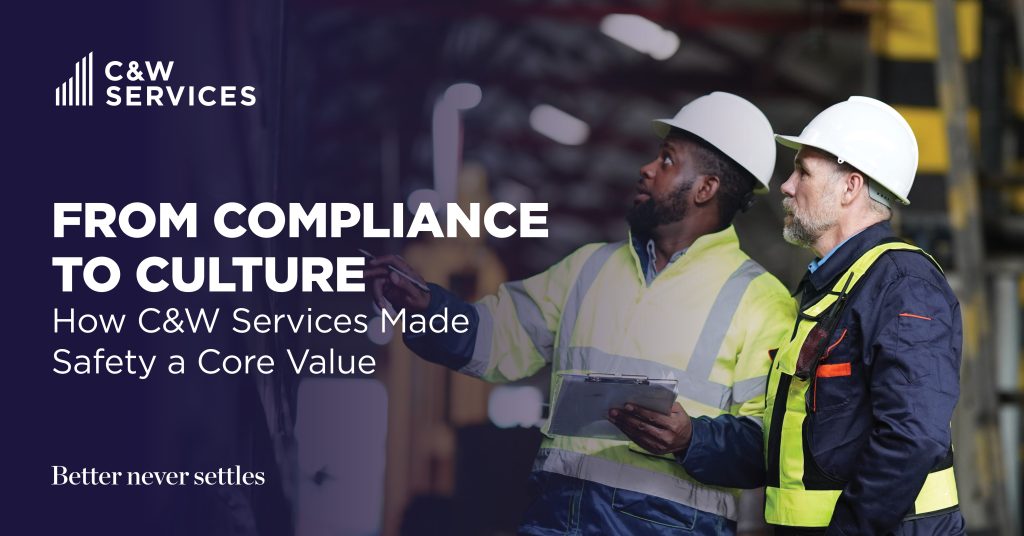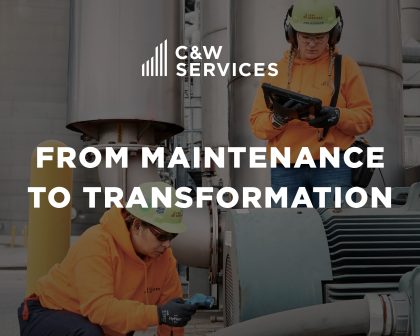
In facilities services, safety is often positioned as a priority—something to balance alongside deadlines, budgets, and client demands. But at C&W Services, that language wasn’t enough. Over time, the company came to view safety as a fundamental human value—something so essential that it shapes how work gets done at every level.
The Turning Point
The shift didn’t start with a new compliance initiative or policy memo. It began with a leadership decision: To embed safety directly into how work is planned, set up, and performed. In other words, to make safety a foundational part of service delivery—not something separate from it.
The transformation also involved acknowledging a key operational truth: You can’t “procedure” or “train” your way out of every hazard. Many risks can’t be captured fully in a document or checklist. So, C&W Services focused on giving frontline employees the tools and authority to identify and address hazards in the moment—reinforcing behavior-based safety and accountability.
“I made a decision that I was going to facilitate hazard reporting–make it easy–under my watch,” recalls Marc Wendell, VP of Environment, Health, & Safety (EHS).
That personal commitment helped drive systems change, with the real shift coming from client service leaders and frontline team members who embraced the mission and made it their own.
This cultural evolution also reframed how the organization views incidents. A safety failure isn’t just a regulatory or insurance concern—it’s a Quality defect, with an opportunity to improve Quality. That understanding now drives continuous improvement, especially in high-demand service environments where pressure can elevate risk. While the company still experiences occasional slips, those moments are used to investigate and strengthen the safety system.
A Living System of Prevention
To bring this culture to life, C&W Services built a safety management system supported by practical, field-tested programs and safe-work practices. These management system “tools” are designed to move the organization beyond compliance—embedding daily work tasks with safe work behavioral practices aimed at preventing incidents. Two of our foundational practices, the supervisory CWalk and the frontline Good Catch, are supported by the following three (3) additional safe-work practices:
• “Take 5” encourages employees to pause before beginning a task and survey their environment for any hazards that may not have been formally identified. Research shows that nearly 29% of serious injuries and fatalities result from a lack of identifying situational hazards. Since every hazard can’t be addressed in written procedures, this five-minute check has become a vital frontline tool.
• “Check It” is an inspection practice, currently focused on housekeeping and trip/fall hazards—a leading cause of worker injuries in recent years, accounting for nearly 50% of claims. The program requires monthly inspections at all sites and reinforces that everyone—not just supervisors—is responsible for maintaining a safe workspace.
• “STARR” (Safety Training And Risk Recognition) is designed to support behavioral safety through real-time engagement. It centers on observing a specific task and ensuring it’s performed as required. But STARR is not an audit—it’s a conversation. Supervisors use STARR as a coaching opportunity to reinforce safe practices and thereby maintain a commitment to safety.
Together, these five (5) safe-work practices create more than a series of checklists or action items —they support an integrated, behavior-driven system that makes safety part of how work gets done. It’s a model built on implementation, engagement, and continuous improvement.
Results and Recognition
The long-term impact of this approach is clear. From a compliance perspective, C&W Services has gone over 14 years without a serious OSHA violation. From a safety perspective, according to the Federal Bureau of Labor Statistics, the company’s OSHA Incident Rates are among the best in our industry (top Quartile tracked by BLS). We’ve also achieved national recognition for our safety performance; in 2024, the company received 76 awards from the National Safety Council (NSC), including NSC “Corporate Culture of Safety” award.
Each of these accomplishments and honors reflects the efforts of people across the organization. Safety incidents are viewed not just as setbacks, but as gaps in the system—opportunities to improve quality and prevent recurrence. That mindset continues to drive progress.
A Culture That’s Lived
The cultural transformation wasn’t driven by top-down enforcement. It began with conviction and evolved through teamwork. From leadership to the frontline, people took ownership of the new approach and made it part of their daily safe-work routines/habits.
Today, safety is not a separate metric. It’s embedded in how the work is planned, executed, and evaluated. The result is an environment where incidents are prevented, not just by rules, but by habits, conversations, and a sense of responsibility.
Safety and Well-Being
As the safety culture continues to evolve, C&W Services is expanding its focus to a broader dimension: the overall well-being of its people. Physical safety remains the foundation, but the company aims to create environments where team members always feel seen, supported, and psychologically safe. From managing stress to promoting emotional resilience, well-being has become an essential part of how the company defines a healthy, high-performing workplace.
This focus on well-being reflects a broader industry movement toward total worker health, recognizing that caring for the whole person is essential to building a resilient and high-performing workforce.
This evolution from safety to well-being marks the next chapter in the company’s culture journey. C&W Services remains committed to leading on all fronts.
Interested in how C&W Services builds safe, high-performing environments for clients across North America? Contact us to learn how we can help elevate your operations through a culture of care, safety, and accountability.




